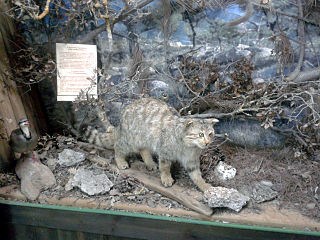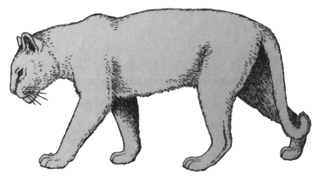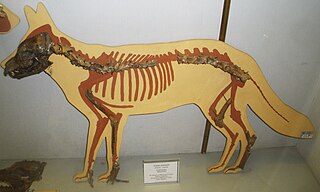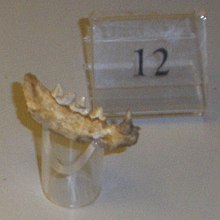
Felidae is the family of mammals in the order Carnivora colloquially referred to as cats. A member of this family is also called a felid.

Felis is a genus of small and medium-sized cat species native to most of Africa and south of 60° latitude in Europe and Asia to Indochina. The genus includes the domestic cat. The smallest of the seven Felis species is the black-footed cat with a head and body length from 38 to 42 cm. The largest is the jungle cat with a head and body length from 62 to 76 cm.

The wildcat is a species complex comprising two small wild cat species: the European wildcat and the African wildcat. The European wildcat inhabits forests in Europe, Anatolia and the Caucasus, while the African wildcat inhabits semi-arid landscapes and steppes in Africa, the Arabian Peninsula, Central Asia, into western India and western China. The wildcat species differ in fur pattern, tail, and size: the European wildcat has long fur and a bushy tail with a rounded tip; the smaller African wildcat is more faintly striped, has short sandy-gray fur and a tapering tail; the Asiatic wildcat is spotted.

The American lion, with the species name meaning "savage" or "cruel", also called the North American lion) is an extinct pantherine cat native to North America during the Late Pleistocene from around 130,000 to 12,800 years ago. Genetic evidence suggests that its closest living relative is the lion, with the American lion representing an offshoot from the lineage of the largely Eurasian cave lion, from which it is suggested to have split around 165,000 years ago. Its fossils have been found across North America, from Canada to Mexico. It was about 25% larger than the modern lion, making it one of the largest known felids to ever exist, and an important apex predator.

Leopardus is a genus comprising eight species of small cats native to the Americas. This genus is considered the oldest branch of a genetic lineage of small cats in the Americas whose common ancestor crossed the Bering land bridge from Asia to North America in the late Miocene.

The Pantherinae is a subfamily of the Felidae; it was named and first described by Reginald Innes Pocock in 1917 as only including the Panthera species, but later also came to include the clouded leopards. The Pantherinae genetically diverged from a common ancestor between 9.32 to 4.47 million years ago and 10.67 to 3.76 million years ago.

Chasmaporthetes, also known as hunting or running hyena, is an extinct genus of hyenas distributed in Eurasia, North America, and Africa during the Pliocene-Pleistocene epochs, living from 4.9 million to 780,000 years ago, existing for about 4.12 million years. The genus probably arose from Eurasian Miocene hyenas such as Thalassictis or Lycyaena, with C. borissiaki being the oldest known representative. The species C. ossifragus was the only hyena to cross the Bering land bridge into the Americas, and ranged over what is now Arizona and Mexico during Blancan and early Irvingtonian Land Mammal ages, between 5.0 and 1.5 million years ago.

The Cretan wildcat is a member of the genus Felis that inhabits the Greek island of Crete. Its taxonomic status is unclear at present, as some biologists consider it probably introduced, or a European wildcat, or a hybrid between European wildcat and domestic cat. It was previously considered a separate subspecies of wildcat as Felis silvestris cretensis.

Panthera gombaszoegensis, also known as the European jaguar, is a Panthera species that lived from about 2.0 to 0.35 million years ago in Europe. The first fossils were excavated in 1938 in Gombasek Cave, Slovakia. Some records were also reported from Africa and Asia. P. gombaszoegensis was a medium-large sized species that formed an important part of the European carnivore guild for a period of over a million years. Many authors have posited that it is the ancestor of the American jaguar, with some authors considering it the subspecies Panthera onca gombaszoegensis, though the close relationship between the two species has been questioned.

The European wildcat is a small wildcat species native to continental Europe, Great Britain, Turkey and the Caucasus. Its fur is brownish to grey with stripes on the forehead and on the sides and has a bushy tail with a black tip. It reaches a head-to-body length of up to 65 cm (26 in) with a 34.5 cm (13.6 in) long tail, and weighs up to 7.5 kg (17 lb).

The African wildcat is a small wildcat species with sandy grey fur, pale vertical stripes on the sides and around the face. It is native to Africa, West and Central Asia, and is distributed to Rajasthan in India and Xinjiang in China. It inhabits a broad variety of landscapes ranging from deserts to savannas, shrublands and grasslands.

Panthera fossilis is an extinct species of cat belonging to the genus Panthera, known from remains found in Eurasia spanning the Middle Pleistocene and possibly into the Early Pleistocene.

The Sardinian wildcat is an isolated population of feral cats on the island of Sardinia, introduced during the Roman Empire. It has historically been misidentified as a species of lynx or a subspecies of wildcat.

Xenocyon is an extinct group of canids, either considered a distinct genus or a subgenus of Canis. The group includes Canis (Xenocyon) africanus, Canis (Xenocyon) antonii and Canis (Xenocyon) falconeri that gave rise to Canis (Xenocyon) lycanoides. The hypercarnivorous Xenocyon is thought to be closely related and possibly ancestral to modern dhole and the African wild dog, as well as the insular Sardinian dhole.

Ugolino Martelli (1860–1934) was an Italian botanist, biologist, and mycologist. Martelli is known for his studies of and contributions to the systematics of the tropical genus Pandanus and his taxonomic definition of the flora of Sardinia. He also specialized in studies of the flora of Tuscany and Malaysia.

Canis arnensis, is an extinct species of canine that was endemic to Mediterranean Europe during the Early Pleistocene. Canis arnensis has been described as a small jackal-like canid. Its anatomy and morphology relate it more to the modern golden jackal than to the larger Etruscan wolf of that time. It is probably the ancestor of modern jackals.

Canis etruscus, is an extinct species of canine that was endemic to Mediterranean Europe during the Early Pleistocene. The Etruscan wolf is described as a small wolf-like dog. It is widely agreed to be the ancestor of Canis mosbachensis, and thus ultimately the modern grey wolf.
Hyperailurictis is an extinct genus of felid from Miocene North America. The Hyperailurictis species are Pseudaelurus-grade felids and thought to be the first felids in the Americas.
Panthera shawi is an extinct prehistoric cat, of which a single canine tooth was excavated in Sterkfontein cave in South Africa by Robert Broom in the 1940s. It is thought to be one of the oldest known Panthera species in Africa.

Felis wenzensis is an extinct species of cat that was described based on fossils from the Pliocene-aged Węże 1 locality in Poland. It is known from only one specimen, a partial left mandibular ramus, and is distinguished from the closely-related felines Felis lunensis and Felis silvestris by its larger teeth.


















